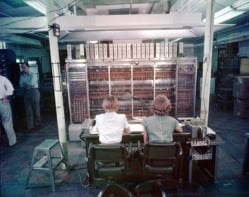Margaret Harris reviews The Winter Fortress: the Epic Mission to Sabotage Hitler’s Atomic Bomb by Neal Bascomb
A few years ago, the Norwegian town of Rjukan literally got its moment in the Sun. Its location deep in a valley meant that for six months of the year, no sunlight reached its inhabitants – until 2013, when giant mirrors installed on a hillside began beaming light into the town centre, delighting locals and visitors alike. This image of light shining into darkness, and of triumph over an apparently insurmountable obstacle, is worth keeping in mind while reading Neal Bascomb’s The Winter Fortress: the Epic Mission to Sabotage Hitler’s Atomic Bomb.
The “fortress” of the book’s title is the Vemork hydropower plant, which sits on a cliff above Rjukan and was, at the outbreak of the Second World War, Europe’s only significant manufacturer of heavy water. This substance, which contains deuterium rather than ordinary hydrogen, was crucial to Nazi Germany’s atomic-bomb project because it acts as a neutron moderator, slowing neutrons to the speeds required to sustain a chain reaction in uranium-235. Hence, after the Nazi invasion of Norway in 1940, the Vemork heavy-water facility became a prime target for Allied sabotage. The Winter Fortress tells the story of the saboteurs: a small band of British-trained Norwegian commandos who endured almost unimaginable hardship and danger to carry out their mission.
It is also the story of Leif Tronstad, a Norwegian atomic chemist who improved Vemork’s heavy-water apparatus before the war and was instrumental in planning its destruction. Both of these intertwined stories are well-researched and told in gripping fashion. At times, one can almost feel the chill of the Norwegian winter or hear the swish of skis as Bascomb relates the saboteurs’ daring deeds. But as he makes clear, the ultimate effect of the saboteurs’ heroic efforts was rather limited. The Nazi atomic-bomb project was poorly funded, riven by internal disputes and, from 1943, subject to attack by Allied bombers. A few months’ delay in heavy-water production was one problem among many.
The German physicists’ reliance on heavy water was also a mistake: graphite (the neutron moderator Enrico Fermi used in his pioneering reactor of 1942) was more readily available and would have worked just as well. For anyone seeking to sensationalize the story of the Norwegian heavy-water saboteurs, these are inconvenient facts, but Bascomb (unlike the authors of some overblown statements on the book’s dust jacket) has no need of such hyperbole. His tale fascinates not because of the saboteurs’ results, but because of what it took to achieve them.
- 2016 Houghton Mifflin £20.00/$28.00hb 400pp


